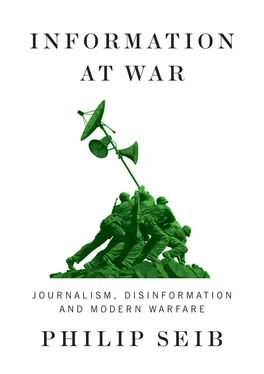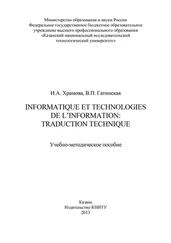Such realization led, a decade later, to the cooperative venture of embedding about 700 American and international journalists with US military units during the early stages of the Iraq War that began in 2003. The embed process was designed cooperatively by the Defense Department and representatives from the news media, and technology was a factor in the Pentagon’s rulemaking. Military commanders knew that satellite broadcasting capability had expanded significantly since the 1991 Gulf War, with gear that was more portable and affordable, and so journalists would have greater ability to escape constraints and report on their own. Beyond that, the military wanted to influence news content without appearing to be doing so. Making journalists beholden for access (and personal safety) was a way to accomplish that. For their part, news organizations wanted to bring their audiences timely, exciting, “up close” reporting from the frontlines. The arrangements that were agreed upon were far from perfect, but they more or less served the interests of both parties. 20
The military units in which journalists were embedded found themselves with their mission expanded in a nontraditional way. Fighting the Iraqi enemy was the principal task, but some soldiers’ frontline responsibilities now included feeding, housing, and safeguarding a coterie of journalists. Most of these journalists had never served in the military and had received only brief training in matters such as first aid and dealing with a chemical weapons attack. Despite their occasional bravado, these men and women were amateurs among warfighting professionals, and they had to be treated with care by their hosts. 21
The military wanted to facilitate news gathering that would show US efforts in the most favorable light to ensure continued popular support from the American public. With the 9/11 attacks of 2001 still very much on the public’s and journalists’ minds, some news organizations decided that putting a patriotic spin on their coverage would appeal to news consumers (and advertisers). 22Mutually beneficial coexistence between combat operations and journalism was becoming a more integral element of military and journalistic doctrine.
Nevertheless, with the Vietnam War still a frequently cited precedent, the government and news media continue at times to wrestle for control of the information flow. As journalists know, the boundaries between “military necessity” and “political expedience” can sometimes be hard to discern when it comes to withholding information or making it available to the public.
Chapter 3, “War Information Expands,” considers the broadened scope of war-related information-gathering. While wars keep being fought and journalists keep covering them, use of new information technologies has extended well beyond the professionals to whom it had long been limited. Perhaps the most revolutionary new tool is the cellphone camera. With it, unseen wars can be brought into the vision of governments and publics, and they can decide whether this information merits intervention in response. Today we can look into the past and ask, “What if …?” about previous wars. What if Tutsis in Rwanda in 1994 had been able to show the world their country’s genocide in progress? Would foreign governments have responded more promptly? A half-century before that, what if the Holocaust had been documented as it happened? Would the Allied powers have altered their strategy and made liberating the Nazi concentration camps a higher priority?
The list of such questions is virtually endless. The device so many of us carry in our pockets today may not have been available to alter events and save lives in the past, but it might do so today. Along with other tools, it is used by “citizen journalists” who have little or no formal journalism training but gather and disseminate descriptions and images of events that take place in front of them. Established news organizations see them as assets. The BBC, for instance, may ask witnesses to terrorist attacks and other such occurrences to provide photos, video, and general information that can be included in news reports. 23Sometimes a deluge of responses is the result. At first glance, this may seem to be a valuable expansion of the flow of news. But vetting can be difficult; once the door is opened, fraudulent photos, videos, and text might come racing through. This means news organizations must pay particular attention to the accuracy of material from citizen journalists. Errors may be deliberate or accidental, but they should not be presented to the public. 24
Nevertheless, citizen journalists’ work can have great value. Syrians reporting from their hometowns during the war that began in 2011 have bravely provided coverage from places that conventional news organizations cannot (or dare not) reach. Rulers such as Syrian President Bashar al-Assad are finding it more difficult to slaughter their opponents without the rest of the world learning about it. How the world will respond to atrocities documented in real time remains open to question, but perhaps this new dimension of information availability will somewhat alter the calculations of bloodletting.
“Slaughter” is not too strong a word to describe what happens in a war, and not just to combatants. Civilian casualties and the destruction of homes, schools, hospitals, and much else tend to receive only secondary attention; they are the detritus of war. But some in the news media and those working for humanitarian organizations are determined that the world should know about this aspect of the costs of war. Cold objectivity sometimes is set aside in favor of a “journalism of attachment” that tells the truth about wartime savagery as it affects individuals. 25
In chapter 4, “Social Media Go to War,” examples of social media’s effects on conflict are reviewed. More sophisticated than citizen journalists are the information arms of nations’ militaries. They battle each other on social media, making their respective cases to near and distant audiences. Given that so many media venues are now global in reach, the contest over worldwide public opinion accompanies even conflicts in which the physical battlefield is small and isolated. Such has been the case between the Israel Defense Forces (IDF) and the Hamas fighters of Gaza. In terms of basic military power, this is a mismatch; the IDF possess much more firepower and other war-fighting technology than their Palestinian opponents do. In an all-out conventional confrontation, the IDF would certainly prevail. But political factors somewhat limit Israel’s combat options, and on the information battleground social media can serve Hamas as a kind of political equalizer if users possess the skills needed to produce attention-getting content.
The IDF–Hamas conflict is relatively transparent for those who want to watch the two sides make their cases in an online debate in which they are armed with words and images. But make no mistake – people still die while the barrages of information fly back and forth.
Non-state actors such as terrorist groups have also found that social media offer congenial platforms for their information purposes. Islamic State, Al Qaeda, and others have relied on online tools for recruiting, fundraising, and delivering a mix of threats and self-promotion, as well as for on-the-ground combat coordination. They use traditional news releases, in several languages, to tout their latest bloody accomplishments, and although mainstream media organizations can deny these extremist groups access to the public through their own venues, wholly excluding tech-smart users from social media is difficult. When Twitter sought to purge Islamic State messaging, it closed down more than 100,000 accounts in just one month, but it was far from certain that this effort had been as comprehensive as intended, and many of these accounts may have been swiftly reconstituted, either on Twitter or in “darker” recesses of the internet. Dealing with terrorist information initiatives will become more important if Islamic State concentrates on a virtual, rather than physical, caliphate, and if groups such as Boko Haram and Al Shabaab become more adept in their online efforts. 26
Читать дальше












